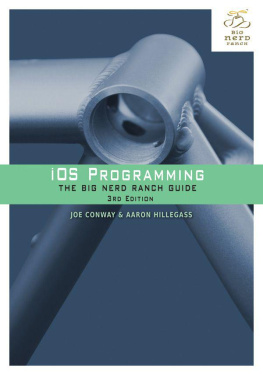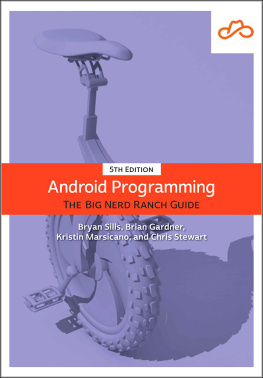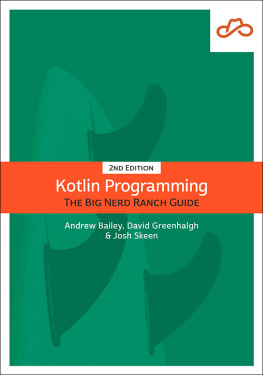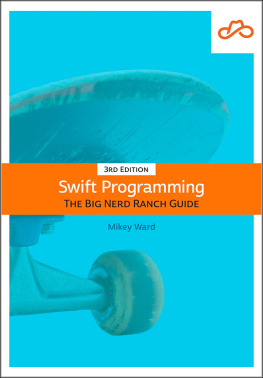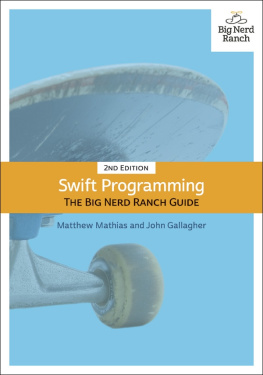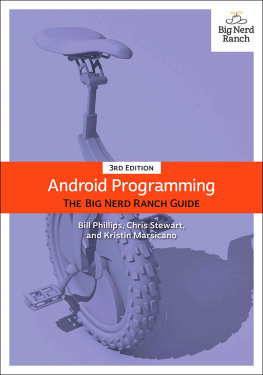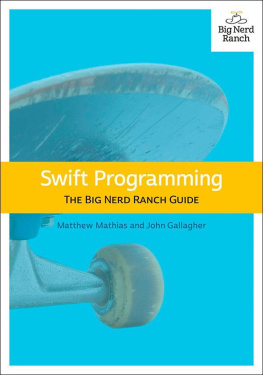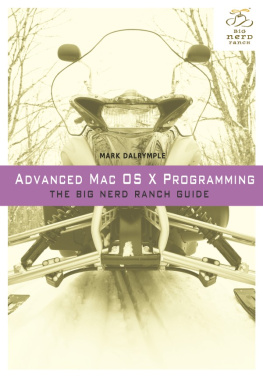iOS Programming: The Big Nerd Ranch Guide
Joe Conway and Aaron Hillegass
Copyright 2012 Big Nerd Ranch, Inc.
All rights reserved. Printed in the United States of America. This publication is protected by copyright, and permission must be obtained from the publisher prior to any prohibited reproduction, storage in a retrieval system, or transmission in any form or by any means, electronic, mechanical, photocopying, recording, or likewise. For information regarding permissions, contact
Big Nerd Ranch, Inc.
154 Krog Street
Suite 100
Atlanta, GA 30307
(404) 478-9005
http://www.bignerdranch.com/
book-comments@bignerdranch.com
The 10-gallon hat with propeller logo is a trademark of Big Nerd Ranch, Inc.
Exclusive worldwide distribution of the English edition of this book by
Pearson Technology Group
800 East 96th Street
Indianapolis, IN 46240 USA
http://www.informit.com
The authors and publisher have taken care in writing and printing this book but make no expressed or implied warranty of any kind and assume no responsibility for errors or omissions. No liability is assumed for incidental or consequential damages in connection with or arising out of the use of the information or programs contained herein.
App Store, Apple, Cocoa, Cocoa Touch, Finder, Instruments, iCloud, iPad, iPhone, iPod, iPod touch, iTunes, Keychain, Mac, Mac OS, Multi-Touch, Objective-C, OS X, Quartz, Retina, Safari, and Xcode are trademarks of Apple, Inc., registered in the U.S. and other countries.
Many of the designations used by manufacturers and sellers to distinguish their products are claimed as trademarks. Where those designations appear in this book, and the publisher was aware of a trademark claim, the designations have been printed with initial capital letters or in all capitals.
Print ISBN-10 0321821521
Print ISBN-13 978-0321821522
Third edition, first printing, March 2012
Release K.3.1.1
Acknowledgments
While our names appear on the cover, many people helped make this book a reality. We would like to take this chance to thank them.
- The other instructors who teach the iOS Bootcamp fed us with a never-ending stream of suggestions and corrections. They are Scott Ritchie, Brian Hardy, Mikey Ward, Christian Keur, Alex Silverman, Owen Matthews, Brian Turner, Juan Pablo Claude, and Bolot Kerimbaev.
- Our tireless editor, Susan Loper, took our distracted mumblings and made them into readable prose.
- Our technical reviewers, Bill Monk and Jawwad Ahmad, helped us find and fix flaws.
- Ellie Volckhausen designed the cover. (The photo is of the bottom bracket of a bicycle frame.)
- Chris Loper at IntelligentEnglish.com designed and produced the print book and the EPUB and Kindle versions.
- The amazing team at Pearson Technology Group patiently guided us through the business end of book publishing.
The final and most important thanks goes to our students whose questions inspired us to write this book and whose frustrations inspired us to make it clear and comprehensible.
Table of Contents
Introduction
An aspiring iOS developer faces three basic hurdles:
- You must learn the Objective-C language. Objective-C is a small and simple extension to the C language. After the first four chapters of this book, you will have a working knowledge of Objective-C.
- You must master the big ideas. These include things like memory management techniques, delegation, archiving, and the proper use of view controllers. The big ideas take a few days to understand. When you reach the halfway point of this book, you will understand these big ideas.
- You must master the frameworks. The eventual goal is to know how to use every method of every class in every framework in iOS. This is a project for a lifetime: there are over 3000 methods and more than 200 classes available in iOS. To make things even worse, Apple adds new classes and new methods with every release of iOS. In this book, you will be introduced to each of the subsystems that make up the iOS SDK, but we will not study each one deeply. Instead, our goal is get you to the point where you can search and understand Apples reference documentation.
We have used this material many times at our iOS Development Bootcamp at Big Nerd Ranch. It is well-tested and has helped hundreds of people become iOS application developers. We sincerely hope that it proves useful to you.
Prerequisites
This book assumes that you are already motivated to learn to write iOS apps. We wont spend any time convincing you that the iPhone, the iPad, and the iPod touch are compelling pieces of technology.
We also assume that you know the C programming language and something about object-oriented programming. If this is not true, you should probably start with an introductory book on C and Objective-C, such as Objective-C Programming: The Big Nerd Ranch Guide.
Whats Changed in the Third Edition?
This edition assumes that the reader is using Xcode 4.3 and running applications on an iOS 5 device or simulator.
With iOS 5, automatic reference counting (ARC) is the default memory management for iOS. Weve redone the memory management chapter to address ARC, and we use ARC throughout the book.
Youll find new chapters on using gesture recognizers, storyboards, NSRegularExpression , and iCloud. Weve also added two chapters dedicated to the the Model-View-Controller-Store design pattern, which we use at Big Nerd Ranch and believe is well-suited for many iOS applications.
Besides these obvious changes, we made thousands of tiny improvements that were inspired by questions from our readers and our students. Every page of this book is just a little better than the corresponding page from the second edition.
Our Teaching Philosophy
This book will teach you the essential concepts of iOS programming. At the same time, youll type in a lot of code and build a bunch of applications. By the end of the book, youll have knowledge and experience. However, all the knowledge shouldnt (and, in this book, wont) come first. Thats sort of the traditional way weve all come to know and hate. Instead, we take a learn-while-doing approach. Development concepts and actual coding go together.
Heres what weve learned over the years of teaching iOS programming:
- Weve learned what ideas people must have to get started programming, and we focus on that subset.
- Weve learned that people learn best when these concepts are introduced as they are needed .
- Weve learned that programming knowledge and experience grow best when they grow together.
- Weve learned that going through the motions is much more important than it sounds. Many times well ask you to start typing in code before you understand it. We get that you may feel like a trained monkey typing in a bunch of code that you dont fully grasp. But the best way to learn coding is to find and fix your typos. Far from being a drag, this basic debugging is where you really learn the ins and outs of the code. Thats why we encourage you to type in the code yourself. You could just download it, but copying and pasting is not programming. We want better for you and your skills.
What does this mean for you, the reader? To learn this way takes some trust. And we appreciate yours. It also takes patience. As we lead you through these chapters, we will try to keep you comfortable and tell you whats happening. However, there will be times when youll have to take our word for it. (If you think this will bug you, keep reading weve got some ideas that might help.) Dont get discouraged if you run across a concept that you dont understand right away. Remember that were intentionally not providing all the knowledge you will ever need all at once. If a concept seems unclear, we will likely discuss it in more detail later when it becomes necessary. And some things that arent clear at the beginning will suddenly make sense when you implement them the first (or the twelfth) time.

